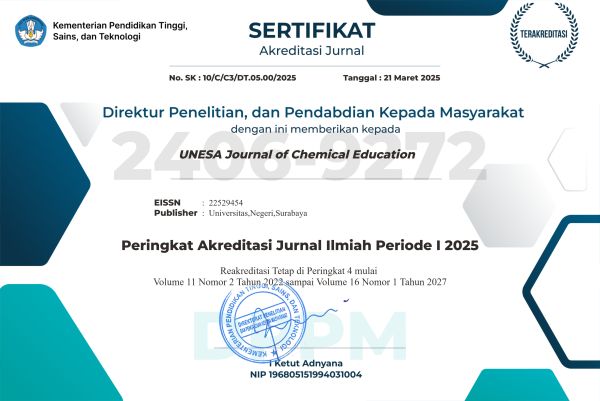REMEDIATION OF THERMOCHEMICAL MISCONCEPTIONS USING A PROBLEM-BASED LEARNING MODEL BASED ON MULTIPLE REPRESENTATION
DOI:
https://doi.org/10.26740/ujced.v13n3.p214-225Keywords:
Remediation of misconceptions, three-tier multiple-choice, problem-based learning modelAbstract
This research aims to describe students’ misconceptions of thermochemical matter at SMAN 8 Pinrang, and then remediate these misconceptions using a problem-based learning model based on multiple representations. The research method used is descriptive analytics. The subjects of this research were class XI F1 students. The data collection instrument used a misconception test of three-tier multiple-choice thermochemical matter with 20 items and an interview guide. Data analysis was carried out using percentages. The research results show that misconceptions occur in the concepts of system and surroundings, exotherm and endotherm, standard enthalpy formation changes, and determining enthalpy changes based on Hess's law. The misconceptions that occur in these four concepts are 1) students identify the container as a system, 2) in exothermic reactions the temperature of the system will decrease because it releases heat into the surroundings, 3) standard formation reactions are identified as being formed from molecules or other compounds, 4) many The reaction stage can affect the magnitude of the enthalpy change. The average reduction in misconceptions for these four concepts was 44% in the medium category. The average reduction in misconceptions for each student is 43% in the medium category.
Downloads
References
Middlecamp, C., and Kean, E. 1985. Panduan Belajar Kimia Dasar. Jakarta: Gramedia.
Mentari, L., Nyoman, S., and Subagia, W. 2014. Analisis Miskonsepsi Peserta Didik SMA pada Pembelajaran Kimia untuk Materi Larutan Penyangga. E-Journal Kimia Visvitalis, Vol. 2, No. 1, pp. 1405-1423.
Ibrahim, M. 2019. Model Pembelajaran C20C2R untuk Mengubah Konsepsi IPA Siswa. Sidoarjo: Zifatama Jawara.
Jusniar, J., Effendy, E., Budiasih, E., and Sutrisno, S. 2020. Misconceptions in Rate of Reaction and Their Impact on Misconceptons in Chemical Equilibrium. European Journal of Educational Research, Vol. 9, No. 4, pp. 1405-1423.
Jusniar., and Syamsidah. 2021. Hubungan Konsep Diri dengan Miskonsepsi Siswa pada Konsep Kesetimbangan Kimia. Jurnal Ipa Terpadu, Vol. 5, No. 1, pp. 96-102.
Murniati, S., Enawaty, E., and Lestari, I. 2018. Deskripsi Miskonsepsi Siswa dalam Menyelesaikan Soal Termokimia pada Siswa Kelas XI MAN Kubu Raya. Jurnal Pendidikan dan Pembelajaran Khatulistiwa (JPPK), Vol. 7, No. 9, pp. 1-8.
Irfandi., Murwindra, R., and Musdansi, D, P. 2022. Analisis Penyebab Miskonsepsi Peserta Didik pada Materi Termokimia di SMAN 1 Teluk Kuantan. Jurnal Pendidikan Dan Konseling, Vol. 4, No. 6, pp. 45-56.
Suyatman., and Taher, T. 2020. Analisis Miskonsepsi Siswa Kelas XI Madrasah Aliyah Negeri 1 (MAN 1) Lampung Timur dalam Mempelajari Pokok Bahasan Termokimia. Jurnal Inovasi Pendidikan Kimia, Vol. 14, No. 2, pp. 2619-2628.
Sihaloho. M., Hadis, S, S., Kilo, A, K., and Kilo A, L. 2021. Diagonosa Miskonsepsi Siswa SMA Negeri 1 Telaga Gorontalo pada Materi Termokimia. Journal Of Educational Chemistry, Vol. 3, No. 1, pp. 7-13.
Habiddin, H., Utari, J. L., and Muarifin, M. 2019. Development and Validation of a Four-Tier Diagnostic Instrument for Chemical Kinetics. Indonesian Journal Chemistry, Vol. 19, No. 3, pp. 720-736.
Nasrudin, H., and Suyono, M. I. 2015. Learning Of Thermochemistry by Connecting the Multiple Representation for Reduction Misconceptions. Prosiding Seminar Nasional Kimia. ISBN: 978-602-0951-05-8, pp.9-14.
Sundaygara, C. 2014. Pengaruh Multi Representasi pada Pembelajaran Berbasis Masalah Terhadap Kemampuan Representasi Siswa SMA. Jurnal Foton, Jurnal Fisika Dan Pembelajaran, Vol. 18, No. 2.
Mariana, I., Fahinu, F., and Ruslan, R. Pengaruh Model PBL dengan Pendekatan Saintifik Terhadap Kemampuan CPS Ditinjau dari Disposisi Matematis Peserta Didik. Jurnal Pendidikan Matematika, Vol. 9, No. 1, pp. 73-80.
Jonassen, D. 2011. Supporting Problem Solving in PBL. Interdisciplinary Journal Of Problem Based Learning, Vol. 5, No. 2, pp. 34-45.
Rosengrant, D., Etkina, E., and Van Heuvelen, A. 2007. An Overview of Recent Research on Multiple Representations. Aip Conference Proceedings, Vol. 883, No. 1, pp. 149-152.
Widarti, H, R. 2022. Desain Program Pembelajaran Berbasis Mutiple Representation Melalui Cognitive Dissonance Untuk Mereduksi Miskonsepsi Kimia. Malang: Universitas Negeri Malang.
Arslan, H. O., Cigdemoglu, C., and Moseley, C. 2012. A Three Tier Test to Assess Pre-Service Teachers’ Misconceptions about Global Warming, Greenhouse Effect, Ozone Layer Depletion, and Acid Rain. International Journal of Science Education, Vol. 34, No. 11, pp. 1667-1686.
Al-Balushi, S. M., Ambusaidi, A. K., Al-Shuaili, A. H., and Taylor, N. 2012. Omani Twelfth-Grade Students’ Most Common Misconceptions in Chemistry. Science Education International, Vol. 23, No. 3, pp. 221–240.
Zumdahl, S. S., and Zumdahl, S. A. 2017. Chemistry Seventh Edition. New York: Houghton Mifflin Company.
Burdge. J and Overby. J. 2018. Chemistry: Atom First. Third Edition. New York: McGraw-Hill Education.
Downloads
Published
Issue
Section
License
The license terms of the Creative Commons Attribution-NonCommercial 4.0 International (CC BY-NC 4.0) requires attribution to the original creator, permits non-commercial use, and does not allow for the application of legal or technological restrictions on others' use.
 Abstract views: 119
,
Abstract views: 119
, PDF Downloads: 277
PDF Downloads: 277













